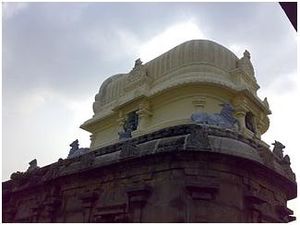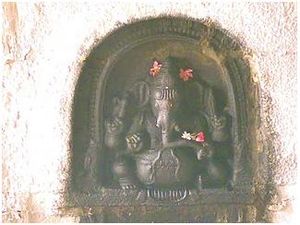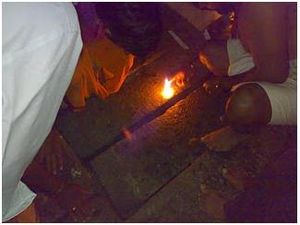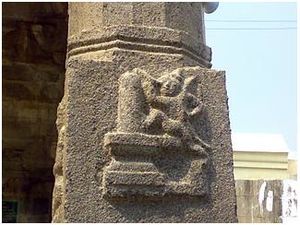Thiruppulivanam Sri Vyaagrapureeswarar
Thiruppulivanam is a small village located just 3 kms from Uthiramerur on the Kanchipuram Road. Thiruppulivanam houses a very ancient temple for Lord Shiva called Sri Vyaagrapureeswarar Temple. Thiruppulivanam got its name as Saint Vyaagrapaadhar worshipped Lord Shiva here. Saint Vyaagrapaadha possessed the body of a human being and legs of a tiger (Sanskrit: vyaagra - tiger, paadha - feet). As this saint worshipped here, the place came to be known as Thiruppulivanam (Tamil: thiru - God, puli – tiger, vanam – forest).
According to legend, it is said that Saint Vyaagrapaadha had taken a boon from Lord Shiva to give him tiger’s legs. With these legs he could leap faster to fetch flowers for Siva Pooja even before the honey bees could touch them. He wanted to wanted to offer the freshest and most pure flowers (untouched even by the bees) to the Lord. Lord Shiva granted his wish and Vyaagrapaadha worshipped the Lord here. One day, a king called Parantaka was infected with a strange disease and was advised to visit this temple. As Parantaka neared the temple, Vyaagrapaadha, out of possessiveness, went and hugged the idol of Shiva Linga. This embrace resulted in the formation of a tiger nail mark on Lord Shiva. It is believed that Lord Shiva then appeared and blessed both the king and the Saint.
As you approach the temple, a beautiful Nandhi seated facing the sanctum shows you the way to the temple. Here you can find the main deity Vyaagrapureeswarar idol in the form of a Shiva Linga with an unusual jada mudi (knot of hair) on it. Also the Aavudaiyar (base of Shiva Linga) here is square-shaped unlike the usual circle shape. The Goddess here is Amrutha Kujaambal, who has a separate Shrine inside the temple on its outer Praakaram. There is a very beautiful Pillaiyar (Ganesha), wonderfully carved on the stone wall at the entrance of the Goddess’s Shrine.
The Dhakshinamurthy is very peculiar here and not seen elsewhere. Dhakshinamurthy offers Dharshan as Ardhanareeswarar (half Shiva & Shakthi). One foot of his is on the Lion and hand holding the Thirisoolam (as Shakthi). Another foot on the Muyalaka Asura (as Shiva). He is seated under the Kallala tree. Around him one can see the 4 Sanath Kumaras (Sons of Brahma), worshipping him. Also seen are Saint Vyaagrapaadhar and Pathanjali Rishi (incarnation of Maha Vishnu’s serpant, Aadhi Sesha). Usually, if there are rishis or saints near the God’s idol, they will be seen near the feet of the Lord worshipping Him. But here Vyaagrapaadhar is seen next to the God standing equally.
It is said that, Vyaagrapaadhar asked for a boon from the Lord that, both this village and the deity should be named after him. Also he should be equally given the importance while devotees worship the Lord. Lord granted his wish and the place was called as Vyaagrapuri (Thiruppulivanam, today) and the Lord is Sri Vyaagrapureeswarar. Also an equal treatment is given to him in Sri Dhakshinamurthy’s Shrine. The temple also has a separate shrine for Vyaagrapuri Siddhar here.
Another unique importance of this temple is, just outside the sanctum, you can see a dark underground tunnel, which is closed with couple of stone slabs. Upon request the priest burns a piece of camphor (pic above) and pushes it through the slit between the slabs and one can see the underground tunnel as a passage (pic below). It is said that this underground passage starts here and ends atUthiramerur Sri Sundara Varadhar Temple. This has been built by some king for their safe hiding etc., during the times of war.
The outer walls of the temple are magnificent with Rishabas (bulls) guarding the temple. In the inner praakaram, one can see the pillars in unique shape which are not commonly seen in any other temples. The Sanctum here is in the circular shape at the back (pic above). This type of Vimana belongs to the Chola style of architecture which is seen in some temples around Chennai, Kanchipuram areas. Such shaped vimanas are called Gaja Brishta (means Elephant’s Back) as they resemble the back of the elephant in sitting posture.
The other deities are Lingothbavar, Pillaiyar, Lord Brahma, Vishnu Durgai, Suryan (Sun God) and Navagrahas. It is said that, from dawn till dusk a bit of sunlight falls on the Lord Suryan’s idol through a diamond shaped small slit on the wall facing Him.
One can see very ancient and beautiful works on the pillars with images of Kannappa Nayanar, Maha Kali etc., sculpted on them. Outside the main temple, in front of the entrance, there is an old, big Mandapam, which is believed to be Indra Mandapam, in which Lord Indra lands here to worship Shiva. It’s in a poor shape with no maintenance, but looks wonderful. Visit this temple once and you will crave for more visits ! !

















